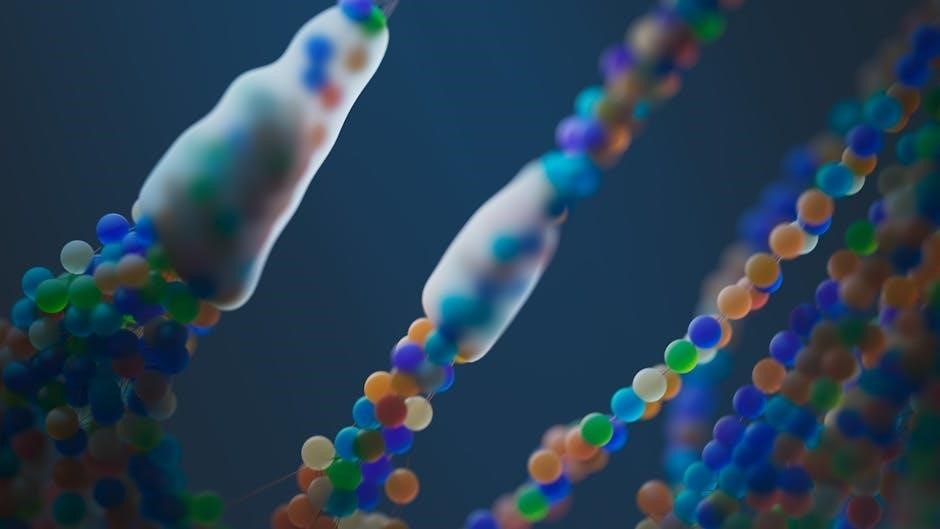The Biology Laboratory Manual 12th Edition by Darrell S. Vodopich and Randy Moore is a comprehensive guide for introductory biology courses, offering detailed experiments and inquiry-based learning to enhance understanding of biological principles through hands-on activities, making it an essential resource for both students and educators.
Overview of the Manual
The Biology Laboratory Manual 12th Edition is a comprehensive resource designed for introductory biology courses. It provides a structured approach to learning, with detailed experiments and activities that cover essential biological concepts. The manual is divided into eight main sections, ranging from cellular biology to ecology, ensuring a broad understanding of the subject. Each section includes hands-on exercises, pre-lab worksheets, and post-lab questions to reinforce learning; The manual also incorporates inquiry-based learning, encouraging students to apply critical thinking skills. With its clear instructions and alignment with course outcomes, the 12th Edition serves as an invaluable tool for both students and educators, fostering a deeper appreciation of biological principles through practical experimentation.
- Covers a wide range of biological topics.
- Includes hands-on experiments and activities.
- Supports inquiry-based learning and critical thinking.
- Provides pre-lab and post-lab resources for enhanced understanding.
Authors and Contributors
The Biology Laboratory Manual 12th Edition is authored by Darrell S. Vodopich and Randy Moore, both renowned experts in biology education. Their collaborative effort ensures a well-rounded and comprehensive approach to laboratory learning. The manual also benefits from contributions by various educators and scientists, providing diverse perspectives and expertise. The authors’ focus on clear instructions and engaging content makes the manual accessible to students at all levels. Their work emphasizes hands-on learning and critical thinking, aligning with modern educational standards. The 12th Edition reflects their commitment to updating and refining content to meet the evolving needs of biology students and instructors alike.
Key Features of the 12th Edition
The Biology Laboratory Manual 12th Edition is distinguished by its enhanced digital integration, offering pre-lab worksheets, investigation guides, and post-lab questions via Connect. It includes over 70 experiments covering topics like the nervous system and microbiology. The manual emphasizes inquiry-based learning, encouraging independent exploration of biological topics. New interactive elements, such as multimedia and navigation tools, improve the user experience. Safety protocols and troubleshooting guides are prominently featured, ensuring efficient lab work. The 12th Edition also provides free PDF access, fostering accessibility and continuous learning. These features collectively create a robust, student-centered resource that aligns with modern educational needs and promotes deeper understanding of biological concepts through hands-on experimentation.

Structure and Organization of the Manual
The manual is organized into eight parts, starting with cellular biology and progressing through genetics, evolution, microbiology, plant and animal biology, and ecology, ensuring a logical flow of topics.
Part 1: The Cell
Part 1 of the Biology Laboratory Manual 12th Edition focuses on the fundamental unit of life: the cell. This section includes experiments designed to explore cell structure, function, and processes. Students investigate cellular transport mechanisms, such as osmosis and diffusion, using potato cubes and beetroot slices. Additionally, activities on enzyme activity and cell respiration provide practical insights into metabolic processes. The section also covers microscopic examination of cells, enabling students to observe and identify key cellular components. Hands-on exercises, such as preparing cheek cell slides, reinforce theoretical concepts. By integrating inquiry-based learning, Part 1 equips students with essential skills in cellular biology, fostering a deeper understanding of life at the cellular level. These experiments are supported by pre-lab worksheets and post-lab questions to enhance learning outcomes.
Part 2: The Genetic Basis of Life
Part 2 of the Biology Laboratory Manual 12th Edition delves into the genetic principles governing life, offering experiments that explore heredity, DNA, and gene expression. Activities include DNA extraction, where students isolate and analyze their own DNA, and simulations of genetic crosses to predict inheritance patterns. Additionally, exercises on PCR (Polymerase Chain Reaction) and restriction enzyme digestion introduce molecular biology techniques. These labs are complemented by investigations into Mendelian laws and pedigree analysis, providing a foundational understanding of genetics. The section also incorporates inquiry-based learning, encouraging students to apply genetic concepts to real-world scenarios, such as CRISPR technology and genetic disorders. This blend of practical and theoretical activities fosters a deep appreciation of the genetic basis of life and its modern applications.
Part 3: Evolution
Part 3 of the Biology Laboratory Manual 12th Edition focuses on the principles and mechanisms driving evolutionary processes. Through hands-on experiments, students explore natural selection, speciation, and the fossil record. Activities include simulations of natural selection using bead populations and analyzing fossil data to reconstruct evolutionary timelines. Additionally, exercises on comparative anatomy and molecular biology reveal how evolutionary relationships are inferred. These labs emphasize the evidence supporting evolutionary theory, such as homologous structures and molecular phylogeny. By engaging in these investigations, students gain a deeper understanding of the mechanisms that shape biodiversity and the interconnectedness of life on Earth. This section bridges theory with practical application, fostering a comprehensive grasp of evolution.
Part 4: Microbiology and Evolution
Part 4 of the Biology Laboratory Manual 12th Edition delves into the intersection of microbiology and evolutionary biology. Students explore microbial diversity, evolution, and adaptation through hands-on experiments. Labs include culturing microorganisms, observing microbial growth, and studying evolutionary adaptations, such as antibiotic resistance. Activities emphasize the role of microorganisms in ecosystems and their evolutionary significance. Exercises on phylogenetic analysis and comparative genomics provide insights into microbial evolution. This section bridges microbiology with broader evolutionary concepts, helping students understand how microbial systems illustrate evolutionary principles. Practical investigations and data analysis foster a deeper appreciation of the dynamic interplay between microbes and their environments, as well as their role in shaping life on Earth.
Part 5: Plant Evolution and Biology
Part 5 of the Biology Laboratory Manual 12th Edition focuses on plant evolution and biology, exploring the diversity, structure, and function of plants. Laboratories emphasize hands-on investigations into plant anatomy, photosynthesis, and genetics. Students conduct experiments on seed germination, plant tissue culture, and the effects of environmental factors on growth. Activities also cover evolutionary adaptations in plants, such as vascularization and flowering. Practical exercises include microscopic analysis of plant cells and tissues, as well as molecular techniques to study plant genetics. This section integrates evolutionary concepts with plant biology, providing a comprehensive understanding of plant life and its significance in ecosystems. Experiments are designed to foster critical thinking and apply biological principles to real-world scenarios.
Part 6: Animal Evolution and Diversity
Part 6 delves into the evolution and diversity of animals, examining the developmental and anatomical variations across species. Laboratories focus on comparative anatomy, exploring body plans, morphology, and physiological adaptations. Students analyze fossil records and phylogenetic trees to understand evolutionary relationships. Practical exercises include dissections of diverse organisms, such as insects, vertebrates, and invertebrates, to study structural adaptations. Molecular techniques are introduced to trace evolutionary changes in animal lineages. This section emphasizes the importance of animal diversity in understanding ecological roles and evolutionary processes. Hands-on activities foster a deeper appreciation of the complexity and adaptability of animal life, connecting evolutionary history to modern biological systems.
Part 7: Comparative Animal Biology
Part 7 focuses on comparative animal biology, exploring the physiological and anatomical differences across various animal species. Laboratories emphasize the study of organ systems, functional adaptations, and evolutionary trade-offs. Students engage in experiments comparing respiratory, circulatory, and digestive systems of diverse organisms, from invertebrates to mammals. Practical investigations include measurements of metabolic rates and analysis of locomotor strategies. This section also incorporates pre-lab worksheets and post-lab questions to reinforce understanding of comparative biological principles. By examining how different animals solve common challenges, students gain insights into the diversity of life and the evolutionary pressures shaping animal biology. These exercises foster critical thinking and appreciation for the complexity of animal physiological systems.
Part 8: Ecology
Part 8 of the Biology Laboratory Manual 12th Edition focuses on ecology, providing hands-on experiments to explore the interactions between organisms and their environments. Laboratories include studies of population dynamics, community interactions, and ecosystem analysis. Students investigate energy flow through ecosystems, nutrient cycling, and the impact of human activities on ecological balance. Practical exercises involve field observations, simulations of predator-prey relationships, and experiments on environmental factors affecting species distribution. Pre-lab worksheets guide students in developing hypotheses, while post-lab questions encourage critical thinking about ecological principles. This section emphasizes the application of ecological concepts to real-world challenges, fostering a deeper understanding of the interconnectedness of life and the environment. These activities prepare students to address global ecological issues effectively.

Experiments and Laboratory Exercises
The Biology Laboratory Manual 12th Edition offers a wide range of experiments designed to enhance understanding of biological principles through hands-on activities, fostering critical thinking and practical application in a structured learning environment.

Experiment Design and Planning
The Biology Laboratory Manual 12th Edition emphasizes the importance of well-structured experiment design and planning to ensure successful laboratory investigations. Each experiment begins with clear objectives, outlining the skills and knowledge students will develop. Pre-lab worksheets and investigation guides are provided to help students prepare thoroughly, fostering critical thinking and organization. The manual encourages inquiry-based learning, prompting students to apply biological concepts to real-world scenarios. By aligning activities with learning outcomes, the manual ensures that students gain practical experience while understanding the scientific method. Troubleshooting tips and safety protocols are also included to address common challenges, making the planning process both comprehensive and user-friendly for students at all levels. This structured approach ensures effective experimentation and meaningful learning experiences.
Conducting Laboratory Investigations
Conducting laboratory investigations in the Biology Laboratory Manual 12th Edition involves hands-on exercises designed to deepen students’ understanding of biological concepts. Each experiment is structured to promote active learning, with step-by-step procedures and safety protocols to ensure successful outcomes. The manual emphasizes the importance of adhering to precautions to avoid errors and achieve accurate results. Students are encouraged to engage in inquiry-based learning, applying theoretical knowledge to practical scenarios. Troubleshooting sections help address common challenges, while pre-lab worksheets guide students in preparing for investigations. By aligning activities with learning objectives, the manual ensures that students gain valuable experience in scientific inquiry and critical thinking. This approach fosters a comprehensive understanding of biological principles through direct experimentation and observation.
Analysis and Interpretation of Data
The Biology Laboratory Manual 12th Edition provides robust resources for analyzing and interpreting data collected during experiments. Students are guided through exercises that involve statistical calculations, graphical representation of results, and drawing meaningful conclusions. The manual includes multiple-choice questions and activities designed to test understanding of data interpretation. Pre-lab and post-lab worksheets help students prepare for investigations and reflect on their findings. Interactive tools and multimedia elements further enhance the ability to analyze data accurately. By aligning these activities with learning outcomes, the manual ensures students develop strong critical thinking and problem-solving skills, essential for scientific inquiry and real-world applications. This focus on data analysis prepares students to interpret complex biological phenomena effectively.
Safety Precautions and Laboratory Protocols
The Biology Laboratory Manual 12th Edition emphasizes the importance of adhering to safety protocols to ensure a secure and efficient laboratory environment. Students are provided with detailed guidelines on wearing protective gear, handling biological specimens, and disposing of hazardous materials. The manual includes specific precautions for experiments involving chemicals, microorganisms, and sharp instruments. Emergency procedures, such as spill management and fire safety, are also highlighted. Digital resources, including safety videos and interactive modules, complement the manual, offering visual aids to reinforce safety practices. By prioritizing safety, the manual ensures that students can conduct experiments confidently while minimizing risks and maintaining compliance with laboratory standards.

Resources and Support Materials
The Biology Laboratory Manual 12th Edition offers a variety of resources, including pre-lab worksheets, post-lab questions, and online tools, to support student learning and educator instruction effectively.
Pre-Lab Worksheets and Investigation Guides
The Biology Laboratory Manual 12th Edition provides detailed pre-lab worksheets and investigation guides to prepare students for lab activities. These resources include objectives, materials lists, and procedural overviews, ensuring students understand the purpose and setup of each experiment. The guides also feature inquiry-based questions to encourage critical thinking and active participation. Available in formats like PDF, Word, and PowerPoint, these materials are accessible and easy to use. They align with the manual’s learning outcomes, helping students develop essential skills in scientific inquiry and experimentation. These tools are designed to enhance preparation, engagement, and overall success in laboratory settings.
Post-Lab Questions and Activities
The Biology Laboratory Manual 12th Edition includes a robust set of post-lab questions and activities designed to reinforce learning and critical thinking. These resources help students analyze and interpret experimental data, ensuring a deeper understanding of biological concepts. The questions cover a range of topics, from basic experiments to complex investigations, and are aligned with the manual’s learning outcomes. Additionally, activities encourage students to reflect on their findings, fostering scientific literacy and problem-solving skills. Available in formats such as PDF and Word, these materials provide a comprehensive way to assess and enhance student performance in laboratory settings. They are an essential component of the manual, supporting both individual and group-based learning experiences.
Online Resources and Digital Tools
The Biology Laboratory Manual 12th Edition is complemented by a variety of online resources and digital tools to enhance learning. These include pre-lab worksheets, investigation guides, and interactive elements accessible via platforms like Connect. The manual is available in formats such as PDF, Word, and PowerPoint, ensuring compatibility with multiple devices. Interactive features like multimedia, virtual lab simulations, and boxed readings encourage engagement. Free PDF resources are also available, making high-quality educational materials accessible to a broader audience. These tools cater to diverse learning styles, providing students with flexible ways to explore biological concepts and reinforce their understanding of laboratory experiments and theoretical principles.
Instructor Materials and Supplements
The Biology Laboratory Manual 12th Edition offers extensive instructor materials and supplements designed to support educators in delivering effective biology courses. These resources include detailed laboratory resource guides, PowerPoint presentations, and customizable lesson plans. Instructors can access supplementary content such as answer keys, test banks, and additional lab exercises through platforms like Connect. These tools allow educators to tailor their teaching to meet the needs of their students while ensuring alignment with the manual’s learning objectives. Additionally, the supplements provide a robust framework for integrating both theoretical and practical aspects of biology, enabling instructors to create a comprehensive and engaging learning experience.

Digital Edition and Accessibility
The Biology Laboratory Manual 12th Edition digital edition offers enhanced accessibility, featuring a user-friendly interface, compatibility with multiple devices, and interactive elements to support diverse learning needs effectively.
Compatibility with Various Devices
The Biology Laboratory Manual 12th Edition digital edition is designed to be accessible across a wide range of devices, ensuring flexibility for students and educators. It is fully compatible with tablets, laptops, and e-readers, allowing users to access content seamlessly on their preferred platform. The PDF format ensures that the manual’s layout and visual elements remain consistent, regardless of the device used. This compatibility makes it easier for students to study on the go or in different learning environments. Additionally, the manual’s digital version is optimized for both portrait and landscape orientations, enhancing readability and user experience. This feature-rich design ensures that the manual is accessible to everyone, promoting inclusive and effective learning.
Navigation and User-Friendly Features
The Biology Laboratory Manual 12th Edition PDF is equipped with intuitive navigation tools, enhancing the learning experience. Users can easily access sections, experiments, and resources through interactive bookmarks and a comprehensive table of contents. The digital edition includes a robust search function, allowing quick location of specific topics or experiments. Hyperlinks within the manual enable seamless navigation between related sections, fostering a more integrated understanding of biological concepts. Additionally, the manual supports zoom functionality for detailed views of diagrams and data, while adjustable font sizes accommodate individual reading preferences. These features ensure that the manual is not only informative but also user-friendly, making it an ideal choice for both students and educators.
Interactive Elements and Multimedia
The Biology Laboratory Manual 12th Edition PDF incorporates a variety of interactive elements and multimedia content to enrich the learning experience. Engaging features such as animations, videos, and virtual labs allow students to visualize complex biological processes and conduct simulations in a controlled environment. Interactive diagrams and 3D models provide detailed views of cellular structures and biological systems, facilitating deeper comprehension. Furthermore, audio explanations and narrated tutorials offer additional support for challenging topics. These multimedia elements are seamlessly integrated into the manual, making it a dynamic and engaging resource for both in-class and independent study. They enhance traditional text-based learning by providing immersive and interactive opportunities for students to explore and understand biological principles.

Troubleshooting and Common Issues
The manual addresses common experimental errors and provides practical solutions, ensuring students can identify and resolve issues efficiently during laboratory investigations and data analysis.
Identifying and Addressing Experimental Errors
The Biology Laboratory Manual 12th Edition includes a detailed troubleshooting guide to help students identify and address common experimental errors. This section provides systematic approaches to diagnosing issues, such as inconsistencies in data collection or improper use of laboratory equipment. By focusing on root causes, students can refine their techniques and improve the accuracy of their results. Practical examples and solutions are offered, enabling learners to understand how to mitigate errors and enhance the reliability of their experiments. This feature not only aids in resolving problems but also strengthens students’ understanding of the scientific method and laboratory best practices.
Technical Support and FAQs
The Biology Laboratory Manual 12th Edition is supported by a robust technical support system and an extensive FAQ section. These resources address common inquiries and technical challenges, ensuring uninterrupted learning. The FAQs cover topics such as software compatibility, digital tool usage, and troubleshooting experimental setups. Additionally, direct access to customer support is available for resolving complex issues. This comprehensive support ensures that users can navigate the manual’s features effortlessly, maximizing their learning experience. The integration of technical assistance and FAQs makes the manual user-friendly and accessible for students and instructors alike.

Where to Access the Biology Laboratory Manual 12th Edition PDF

The Biology Laboratory Manual 12th Edition PDF is available through official retailers, academic libraries, and open-access platforms, ensuring easy access for students and educators worldwide.
Official Sources and Retailers
The Biology Laboratory Manual 12th Edition PDF can be accessed through official retailers such as McGraw-Hill, Amazon, and Barnes & Noble. These platforms offer both print and digital versions, ensuring convenience for students and educators. Additionally, the PDF is available for purchase or rent through over 30 bookstores, providing flexible options to meet different needs. Official sources guarantee authenticity and quality, making them the preferred choice for acquiring this essential resource. Students can also check with their university bookstores for availability, as many institutions stock this manual for introductory biology courses. This ensures easy access and supports academic success.

Academic Platforms and Libraries
Academic platforms and libraries provide convenient access to the Biology Laboratory Manual 12th Edition PDF. Many universities and colleges offer this resource through their online libraries or learning management systems, ensuring students can access it for their studies. Additionally, platforms like JSTOR, ScienceDirect, and university databases often host the PDF version, making it easily accessible for registered users. Libraries may also provide physical copies or e-book versions, catering to different learning preferences. Students can log in using their institutional credentials to download or view the manual, ensuring uninterrupted access to its comprehensive content and experiments.
Free Resources and Open Access
Free resources and open access platforms offer convenient ways to obtain the Biology Laboratory Manual 12th Edition PDF without purchase. Websites like Issuu, Scribd, and online archives often host free versions of the manual, allowing students to access experiments and exercises. Additionally, some academic platforms provide open-access materials, enabling users to download or view the PDF without subscription. These resources are particularly beneficial for students with limited financial means, ensuring equitable access to educational content. By exploring these platforms, learners can acquire the manual and engage with its comprehensive lab guides and activities, fostering a culture of continuous learning and academic success. Always verify the credibility of sources to ensure authenticity and quality.